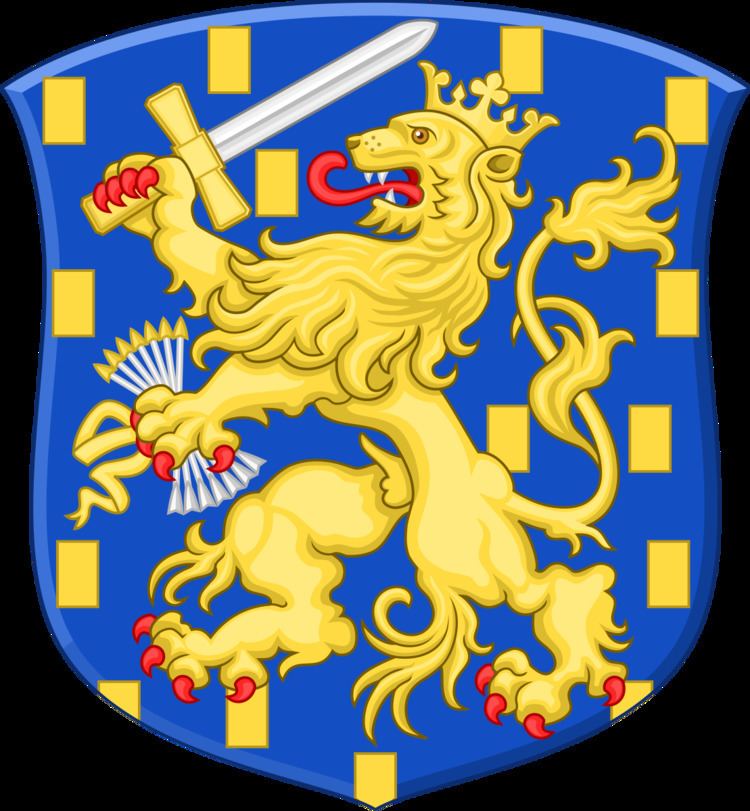 | ||
The study of Dutch heraldry focuses on the use of coats of arms and other insignia in the country of the Netherlands. Dutch heraldry is characterised by its simple and rather sober style, and in this sense, is closer to its medieval origins than the elaborate styles which developed in other heraldic traditions.
Contents
History
The Netherlands, and more generally the Low Countries, was an area significant to heraldic development in medieval times. One of the famous armorials is the Gelre Armorial, written between 1370 and 1414. Coats of arms in the Netherlands were not controlled by an official heraldic system like the two in the United Kingdom, nor were they used solely by noble families. Any person could develop and use a coat of arms if they wished to do so, provided they did not usurp someone else's arms, and historically, this right was enshrined in Roman Dutch law. As a result, many merchant families had coats of arms even though they were not members of the nobility. These are sometimes referred to as burgher arms, and it is thought that most arms of this type were adopted while the Netherlands was a republic (1581-1806). This heraldic tradition was also exported to the erstwhile Dutch colonies, such as South Africa, where it influenced South African heraldry.
Civic heraldry
Dutch civic heraldry is regulated by the High Council of Nobility (Dutch: Hoge Raad van Adel), which grants the arms of provinces, municipalities, water boards, Roman Catholic dioceses and Roman Catholic basilicas.
Most Dutch civic arms were originally recorded and confirmed in the years following the establishment of the Kingdom of the Netherlands in 1815, when mayors were asked to send in the coat of arms traditionally used. Some coats of arms recorded at that time were based on seals. In instances where the original tincture of the arms was unknown or unclear, the arms were blazoned in the ‘national tinctures’ or and azure, the colours of the royal arms. In the twentieth century, the faulty blazon of a number of these arms was subsequently corrected, when historical colours became clear or charges turned out to be misinterpreted.
Generally, the High Council pursues a policy of stylistic simplicity, as decreed by Interior Ministry guidelines from 1977. Most modern grants occur as a result of administrative reforms, with municipalities merging into larger ones. Usually, a civic body submits a proposal to the High Council which adapts it to meet heraldic standards. Regional historical or genealogical societies are known to have been involved drawing up these initial designs. Newly formed municipalities tend to press for inclusion of elements of the old arms of the constituting municipalities into the new arms, with the High Council sometimes rejecting proposals on the grounds that they are ‘overcharged’.
Helmets, crests and mantling are generally absent in Dutch civic heraldry; instead a system of rank coronets is used. Exceptions are the national arms and the coat of arms of Beverwijk. Supporters, mottoes and atypical coronets are only granted if there is historical evidence for them being used, or if a preceding grant featured them. A notable exception to this rule are arms granted to newly created municipalities of Flevoland in the late 1970s and early 1980s which feature seals, sealions and seahorses as supporters, the use of which was previously unknown in civic heraldry in the Netherlands. A few municipalities have renounced their right to supporters in recent years. Mottoes being generally rare, recent years have seen some pre-1795 mottoes being granted again.
The High Council generally disapproves of quartering of existing arms and has a policy not to include the figure of saints on shields. As the names of a number of recent fusion municipalities refer to water bodies or courses within their boundaries, an ordinary representing ‘water’ is an ever often occurrence in recent grants, with the High Council calling them "typical of Dutch heraldry" in 2004 and 2010.
